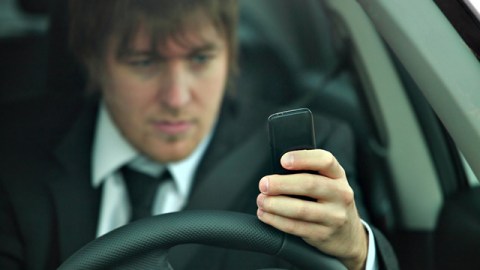Texting, Driving and Mindfulness

Two weeks ago, after turning onto Route 10 from Santa Monica, a truck sped by in the center lane. A hand truck flew from the back as it hit a bump, nearly crashing into the car ahead of me. The car slammed on its brakes, narrowly avoiding the whizzing dolly. I followed suit and slid into the back of that car.
Fortunately no one was hurt, save my Impreza, which as of this morning is in my possession again. It was one of those moments in which time slowed to a painful trickle. No matter how sluggardly existence felt, impact was inevitable. Even with all my wits about me there was no wiggle room. It made me think, what if I hadn’t been paying attention? How much more severe would the crash have been?
The accident replayed in my mind while watching Werner Herzog’s new documentary, ‘From One Second to the Next.’ Funded by AT&T, the film looks into the lives of a handful of people who have either caused or been hurt by (or lost family to) accidents due to texting and driving—at this moment, 100,00 automobile accidents occur every year.
I missed this whole trend while living in New York City for 12 years. The worst I dealt with was inconsiderate folk who couldn’t make it up a flight of subway stairs without pausing to blast unnecessary blabber. Annoying, but not dangerous. So I was shocked when moving to Los Angeles nearly two years ago to find how many times I’ve spotted people at lights and stop signs, head down, typing away, or worse, on the highway attempting a one-handed text.
Herzog was already one of my favorite documentary filmmakers; this moves him from interesting (Happy People, Grizzly Man) and informative (Encounters at the End of the World) to timely and necessary. It’s appalling that so many lives have been lost by this completely useless form of communication. The film inspired the theme in my classes: our cultural loss of focus and how yoga can help reacquaint us with it.
As neuroscience is making progress in helping to stave off Alzheimer’s and other degenerative diseases, mindfulness meditation is making remarkable clinical strides. The practice is rather simple, even if its implementation is not: focus purely on one thing for an extended period of time. It does not have to be seated meditation; the list can include making coffee, breathing, going to the bathroom and walking. The trick is not being distracted by anything while performing the task, including the mini-computer that beckons every moment of our waking lives.
Mindfulness is an important component of yoga asana classes. Yogis must pay attention not only to their internal and muscular alignment in connection with their breathing, but the instructions given by the teacher. As every pose has a number of anatomical subtleties to focus on, there is no room to devote mental energy anywhere else.
While my classes are generally not overly restrictive, the one ‘rule’ I have is that no one peers at their phones—unless they are a doctor on call or a mother with a sick child, or other plausible explanations. In such cases, I’m just happy they’ve carved out time to practice. Sadly, though, I’ve had to enforce this ‘rule’ more times than I care to remember in my decade of teaching.
Putting away the phone during a class is a valuable tool in helping overcome cell phone addiction. The dopamine boost in our brains every time we send or receive a text or email has spilled over from the inconsiderate (subway stairs, sidewalks, cash registers) to the dangerous (driving). Like any addiction, neural rewiring is required to overcome the impulse.
Or, sadly, tragedy. As Chandler Gerber explains in Herzog’s film, he thought texting behind the wheel was no big deal, until he ran into a horse and buggy in Amish territory. It took three people dying for him to realize the text he sent to his wife—“I Love You”—could have waited the twenty minutes it would have taken to arrive at his destination. This is not an isolated story.
According to Slate, ‘From One Second to the Next’ will be shown in 40,000 high schools this fall. That’s a wonderful start. Given that the film has racked up 1.5 million views in less than a week, it is making an impact—friends have told me they’re never picking up their phone while on the road again. This might not completely solve our inability to focus on one thing at a time, but it at least starts to shift us from dangerous back to plain inconsiderate. A cure for that might take more time; with mindfulness practices, we have a foundation to work from.
Image: Peter Gudella/shutterstock.com





